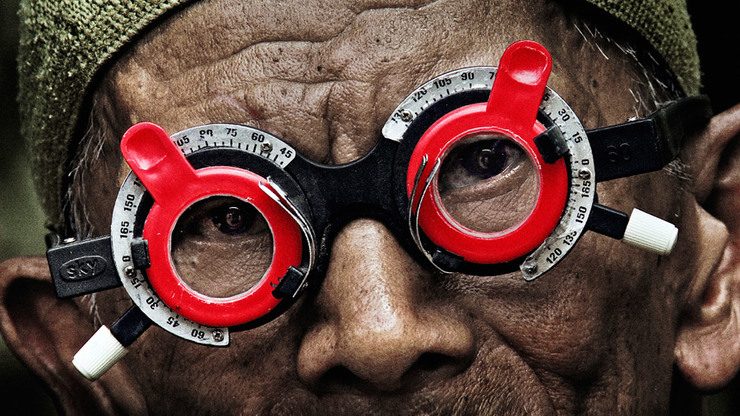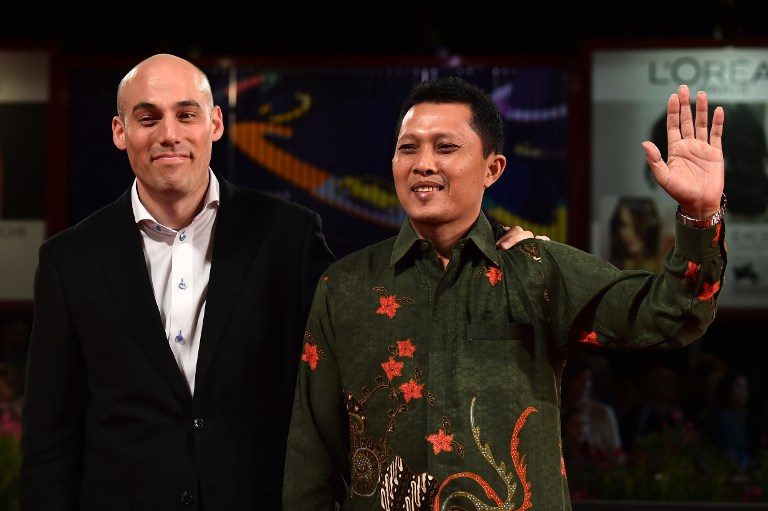SUMMARY
This is AI generated summarization, which may have errors. For context, always refer to the full article.

With eyes fixed on his television screen, Adi Rukun, the main character followed by documentary maker Joshua Oppenheimer in his new film, The Look of Silence, seems to face a mirror that resurrects a nightmarish past.
In the footage that he is watching, two old men sit by the bank of the Snake River and proudly narrate the various killing methods they deployed in Indonesia’s 1965-66 anti-communist massacre. Oppenheimer and his crew were behind the camera, filming.
The men, Amir Hasan and Inong, explain in grisly detail how they murdered Ramli, Adi’s brother. Adi and Ramli never met. Attempting to describe Adi’s reaction would only reveal the limits of our capacity to understand the pain of others. This is, perhaps, the look of silence.
The screen as a mirror
Oppenheimer’s The Look of Silence premiered in Indonesia earlier this month. The companion piece to his Oscar-nominated 2012 film The Act of Killing deals with a survivor’s quest for justice.
Adi, a 44-year-old optometrist, decides to confront his brother’s murderers. The particular scene in which Adi watches Oppenheimer’s footage lingers in my mind as it evokes questions around the concept of the “mirror”.
That TV screen on which he watches his brother’s killers works something like a mirror. It presents a horrifying truth and gives him a deeper access to the perpetrators’ story.
Oppenheimer has used the analogy of the mirror in interviews to describe his films. The Act of Killing, according to him, held up a “dark mirror” to Anwar Congo and to Indonesian society as a whole.
Rejection and reconciliation
Some viewers criticized Oppenheimer for allowing killers to indulge in their morbid fantasies in The Act of Killing. The Look of Silence is more piercing in its subtlety than The Act of Killing and offers something of a response to this criticism.
Adi’s profession as an optometrist is a powerful metaphor for his bold but forgiving character. He wishes to fix the way we see the world rather than to take an eye for an eye.
In the film, the killers and their families deny their guilt – except for one occasion when Adi visits a man and his daughter. This man admits drinking the blood of his victims to stay sane. Shaken by this chilling confession, the daughter apologises for him. In an awkward, painful moment, Adi embraces her. It is one of the most moving scenes in the film and it might serve as what Oppenheimer calls “a model for reconciliation.”
This embrace wouldn’t have been possible, of course, without Oppenheimer orchestrating the meetings – even if Adi initiated the idea of facing his brother’s killers.
In a village where the killers won, the power relation between survivors and the perpetrators is straightforward. What’s not clear on screen is the power relation that exists between the filmmaker and his subjects.

What conditions enable the director to hold up the mirror? What if we can’t see the mirror-holder reflected on screen?
Power relations in the production process, especially involving subjects who are economically and culturally less privileged, has been a central concern of debates about documentary film-making. Consent and cooperation do not guarantee that documentary subjects possess knowledge that equals that of the filmmaker about the implications of camera angles, shot-to-shot relations, and the overall narrative structure.
The Act of Killing had a significant political impact in Indonesia and internationally – and The Look of Silence may make a similar impression. Is this kind of film-making ethical?
Southeast Asian historian Gerry van Klinken argues that The Act of Killing is not unethical because its aim is not to exploit “the moral cretinism” of a particular group but, instead, to pose a critique of Indonesia as a whole.
But I can’t ignore the power of the director holding up the mirror. He offers a particular frame for me to interpret the image – which implicates me in the power relation. The frame, as I understand it, is that The Act of Killing opens up the space, breaking the silence after 47 years, and The Look of Silence fills the space with further actions.
Indonesians have not been silent
Adi’s profession as an optometrist is a powerful metaphor for his bold but forgiving character. He wishes to fix the way we see the world rather than to take an eye for an eye.
The Act of Killing and The Look of Silence project “Indonesia as a whole” as a coherent image, a country where the killers rule. It maps a continuity rather than a conclusive break with the authoritarian period of our history.
Yet, the face of Indonesia that I know and experience, as I’ve written previously in relation to The Act of Killing, is cracking. Various national debates demonstrate a highly divided society and distrust over state institutions.
Shifting ideas of the nation, existing in tension with the remnants of authoritarianism, result in counter-discourses about 1965-66 that have been circulated since the fall of former president Suharto. Indonesians, to borrow from scholar Leslie Dwyer’s phrase, “have not been silent”.
It is this rupture – and not the cohesiveness of the “Indonesia as a whole” that explains why so many are invested in Oppenheimer’s project, why “Anonymous” crews support the production, and why it was possible to screen The Act of Killing more than 1,000 times throughout the country.
A need for structural change
Despite the persisting cultural movement since Suharto’s downfall, the infrastructures that prevent Indonesians from contesting the official narrative of 1965-66 remain unchanged. We need structural changes within Indonesia to do this.
I share a restlessness for change with Oppenheimer. And yet how do I reconcile the distance between myself and the man who holds up the mirror for me?
We need to position Oppenheimer’s films within the network of cultural activism that already exists in Indonesia. This, however, requires a more open discussion about the ramifications of power as part of the process of making and circulating documentaries such as The Act of Killing and The Look of Silence – and the limitations of activists and filmmakers in creating cultural interventions.

Intan Paramaditha is a fiction writer and lecturer at the English Department, University of Indonesia. She recently received her Ph.D in Cinema Studies from New York University. She can be reached at intanparamaditha.org or Twitter @sihirperempuan
This article was originally published on The Conversation. Read the original article.
Add a comment
How does this make you feel?
There are no comments yet. Add your comment to start the conversation.